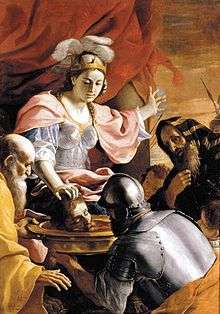Tomyris
Tomyris (/ˈtɒmɪrɪs/; from Old Iranian: Tahma-Rayiš «Beautiful appearance»[1]. also called Thomyris, Tomris, Tomiride, or Queen Tomiri, reigned over the Massagetae, an Iranian people from Scythian pastoral-nomadic confederation of Central Asia east of the Caspian Sea, in parts of modern-day Turkmenistan, Afghanistan, western Uzbekistan, and southern Kazakhstan.[2][3][4][5] Tomyris led her armies to defend against an attack by Cyrus the Great of the Achaemenid Empire, and, according to Herodotus, defeated and killed him in 530 BC.

.jpg)

History
The names of Tomyris, and her son Spargapises, who was the head of her army, are of Iranian origins.[6] Since the historians who first wrote of her were Greek, the Hellenic form of her name is used most frequently.
Many Greek historians recorded that she "defeated and killed" Cyrus the Great, founder of the Achaemenid Empire, during his invasion and attempted conquest of her country. Herodotus, who lived from approximately 484 to 425 BC, is the earliest of the classical writers to give an account of her career, writing almost one hundred years later. Her history was well known and became legendary. Strabo, Polyaenus, Cassiodorus, and Jordanes also wrote of her, in De origine actibusque Getarum ("The origin and deeds of the Goths/Getae").[7]
According to the accounts of Greek historians, Cyrus was victorious in his initial assault on the Massagetae. His advisers suggested laying a trap for the pursuing Scythians: the Persians left behind them an apparently abandoned camp, containing a rich supply of wine. The pastoral Scythians were not used to drinking wine—"their favored intoxicants were Hasheesh with fermented mare's milk"[8]—and they drank themselves into a stupor (with the alcohol deliberately left behind by Cyrus). The Persians attacked while their opponents were incapacitated, defeating the Massagetae forces, and capturing Tomyris' son, Spargapises, the general of her army. Of the one third of the Massagetae forces that fought, there were more captured than killed. According to Herodotus, Spargapises coaxed Cyrus into removing his bonds, thus allowing him to commit suicide while in Persian captivity.[9]
Tomyris sent a message to Cyrus denouncing his treachery, and with all her forces, challenged him to a second battle. In the fight that ensued, the Massagetae got the upper hand, and the Persians were defeated with high casualties. According to Herodotus, Cyrus was killed and Tomyris had his corpse beheaded and then crucified,[10] and shoved his head into a wineskin filled with human blood. She was reportedly quoted as saying, "I warned you that I would quench your thirst for blood, and so I shall"[11][12] (Hdt 1.214)[9] Xenophon, on the other hand, says that Cyrus died peacefully in his bed,[13] and a number of other sources report different causes of death.
Legacy


Eustache Deschamps added Tomyris to his poetry as one of the nine Female Worthies in the late 14th century.
In Shakespeare's earliest play King Henry VI (Part I), the Countess of Auvergne while awaiting Lord Talbot's arrival speaks these lines (Act II, Sc.iii):
The plot is laid: if all things fall out right,
I shall as famous be by this exploit
As Scythian Tomyris by Cyrus' death.— Henry VI ptI, act II, sc.iii.[14]
Shakespeare's reference to Tomyris as 'Queen of the Scythians', rather than the usual Greek designation 'Queen of the Massagetae', points to two possible likely sources, Marcus Junianus Justinus' "Abridged Trogus Pompeius"[15] in Latin, or Arthur Golding's translation (1564).[16]
The history of Tomyris has been incorporated into the tradition of Western art; Rubens,[17] Allegrini,[18] Luca Ferrari,[19] Mattia Preti, Gustave Moreau and the sculptor Severo Calzetta da Ravenna[20] are among the many artists who have portrayed events in the life of Tahm-Rayiš and her defeat of Cyrus and his armies. She is one of the subjects grouped under the Power of Women topos by art historians.
In 1707 the opera Thomyris, Queen of Scythia was first staged in London.[21][22]
The name "Tomyris" also has been adopted into zoological taxonomy, for the Tomyris species group of Central American moths and the Tamyris genus of skipper butterflies.[23]
590 Tomyris is the name given to one of the minor planets.
In popular culture
- Toʻmarisning Koʻzlari (The Eyes of Tomyris) is a 1984 book of poems and stories by Uzbek author Xurshid Davron. Toʻmarisning Aytgani (The Sayings of Tomyris) is a 1996 book of poetry by Uzbek poet Halima Xudoyberdiyeva.
- The Kazakhstani film studio "Kazakhfilm" released the film Томирис (Tomyris) in late 2019. [24] [25]
- Tomyris leads the Scythian civilization in the 2016 4X video game Civilization VI developed by Firaxis Games.[26][27]
- Washington D.C. based, female-fronted, heavy metal band A Sound of Thunder, features a song titled "Tomyris" based on the historical figure, on their sixth full-length album It Was Metal released in 2018.[28]
Footnotes
- Franz Altheim; Ruth Stiehl (1970). "Zweites buch. Ostiran bis auf Alexander den grossen". Geschichte Mittelasiens Im Altertum (in German). Berlin: Walter de Gruyter. pp. 127–8. ISBN 978-3-11-086547-9.
Eines Wortes noch bedürfen die Massageten. Ihre Königin heißt bei Herodot Τόμυρίς, Entsprechung eines avest. *tahma-rayiš „deren Prunk die Gestalt, Figur ist". Demnach zu tahma- und rayay- „Prunk, Reichtum“ gehörig!. Ähnlich heißt ihr Sohn Σπαργαπίσης (Herodot 1, 211; 213): avest. sparəγa-paēsa- „dessen Schönheit einem Schößling gleicht?, zu sparəγa- „Sproß, Schößling" und paēsa- „Schönheit". Schwieriger ist der Stammesname der Massageten zu erklären; es bedarf dazu eines weiteren Ausholens.
- Karasulas, Antony. Mounted Archers Of The Steppe 600 BC-AD 1300 (Elite). Osprey Publishing, 2004, ISBN 978-1-84176-809-0, p. 7.
- Wilcox, Peter. Rome's Enemies: Parthians and Sassanids. Osprey Publishing, 1986, ISBN 0-85045-688-6, p. 9.
- Gershevitch, Ilya. The Cambridge History of Iran (Volume II). Cambridge University Press, 1985, ISBN 0-521-20091-1, p. 48.
- Grousset, René. The Empire of the Steppes. Rutgers University Press, 1989, ISBN 0-8135-1304-9, p. 547.
- For the etymology see: F. Altheim und R. Stiehl, Geschichte Mittelasiens im Altertum (Berlin, 1970), pp. 127–8
- "The Origin And Deeds Of The Goths". ucalgary.ca. 1997-04-22. Retrieved 2010-05-14.
- Mayor, Adrienne. Greek Fire, Poison Arrows, and Scorpion Bombs: Biological and Chemical Warfare in the Ancient World. New York, Overlook Duckworth, 2003; p. 158.
- Halsall, Paul (August 1998). "Herodotus: Queen Tomyris of the Massagetai and the Defeat of the Persians under Cyrus". Internet Ancient History Sourcebook. Retrieved 2010-05-14.
- Mayor, pp. 157–9.
- Herodotus Book One (205)-(214)
- "More Women Rulers". Women in World History Curriculum. 1996–2010. Retrieved 2010-05-14.
- Xenophon, Cyropaedia VII. 7; M.A. Dandamaev, "Cyrus II", in Encyclopaedia Iranica, p. 250. See also H. Sancisi-Weerdenburg "Cyropaedia", in Encyclopaedia Iranica, on the reliability of Xenophon's account.
- Shakespeare, Henry VI, part I., act II, sc.iii http://shakespeare.mit.edu/1henryvi/full.html
- https://archive.org/stream/iustinihistoria00unkngoog#page/
- The Reader's Companion to The Death of Shakespeare By Jon Benson https://books.google.de/books?id=ekygCwAAQBAJ&pg
- "Питер Пауэль Рубенс (Peter Paul Rubens). Queen Tomyris before the Head of Cyrus. Масло на холсте. The Museum of Fine Arts, Boston, MA, USA". staratel.com (Russian). 2006. Retrieved 2010-05-14.
- "Francesco Allegrini, attrib. to Italian, 1587 – 1663, Tomyris and Cyrus, 17th century". Fine Arts Museums of San Francisco. 2006. Archived from the original on 2009-09-15. Retrieved 2010-05-14.
- "Queen Tomyris with the head of Cyrus the Great by Ferrari, Luca (1605–54)". Bridgeman Art Library. Archived from the original on 2011-07-19. Retrieved 2010-05-14.
- "The Frick Collection". collections.frick.org. 1998–2005. Archived from the original on 2013-10-05. Retrieved 2010-05-14.
- "Thomyris, queen of Scythia. An opera, as it is perform'd at the Theatre Royal in Drury-Lane. Most humbly inscrib'd to the Right Honourable the Lord Ryalton. By P. Motteux". hathi.trust.org. HathiTrust Digital Library. Retrieved 8 December 2019.
- Margaret Ross Griffel (21 December 2012). Operas in English: A Dictionary. Scarecrow Press. p. 13. ISBN 978-0-8108-8325-3.
- "Butterflies and Moths of the World". Natural History Museum Website. Retrieved September 22, 2016.
- https://tengrinews.kz/cinema/akan-sataev-raskryil-imya-aktrisyi-kotoraya-337828/
- https://www.goldenglobes.com/articles/tomiris-kazakhstan
- "Civilization VI: Tomyris Leads Scythia". Official Civilization Website. August 9, 2016. Retrieved August 27, 2016.
- "Tomyris of the Scythians will slake your thirst for blood in 'Civilization VI'". Digital Trends. August 9, 2016. Retrieved August 24, 2016.
- Tomyris by A Sound of Thunder, retrieved 2018-07-20
References
- Orosius, Historiae adversus paganos II.7
- Justtinus, Epitome Historiarum philippicarum Pompei Trogi I.8
External links
| Wikimedia Commons has media related to Queen Tomyris. |